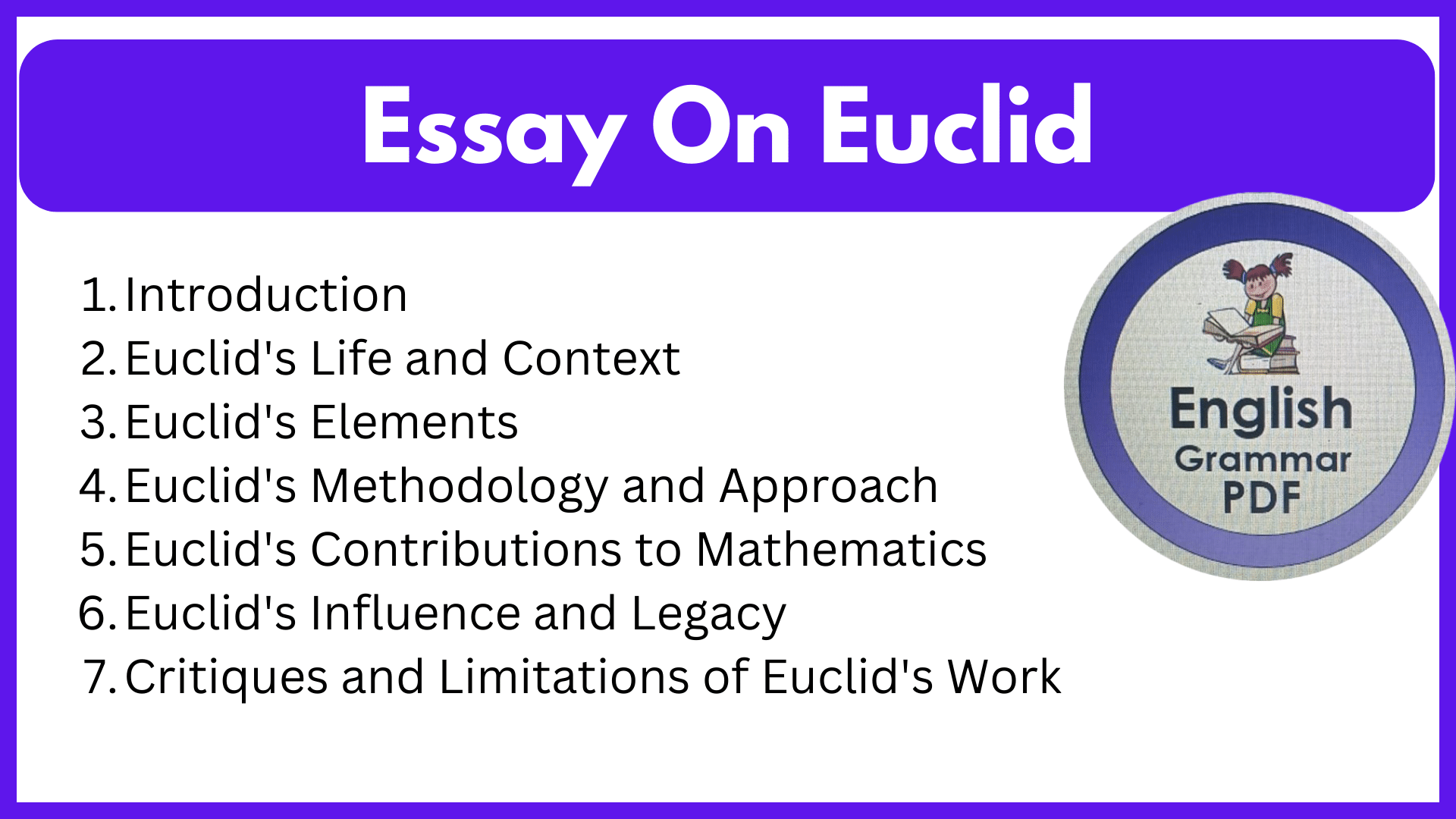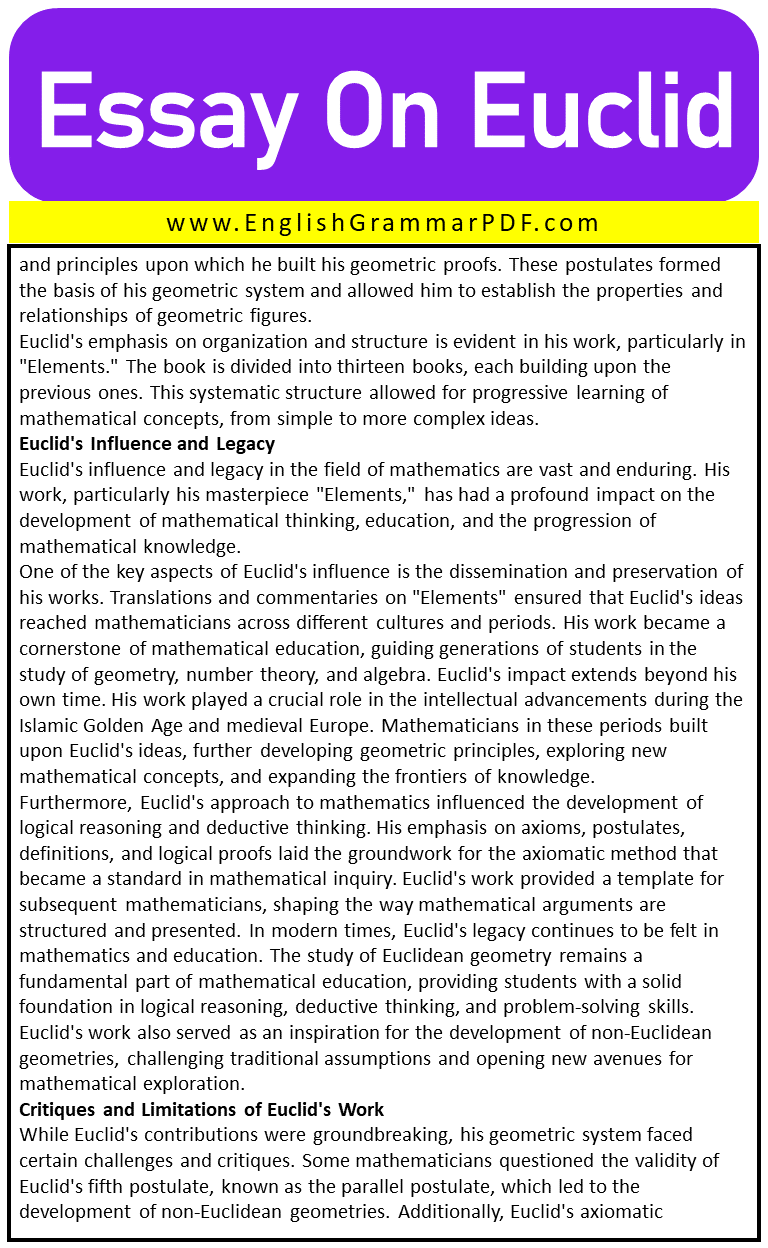Essay On Euclid
Outline of Essay:
- Introduction
- Euclid’s Life and Context
- Euclid’s Elements
- Euclid’s Methodology and Approach
- Euclid’s Contributions to Mathematics
- Euclid’s Influence and Legacy
- Critiques and Limitations of Euclid’s Work
Introduction
Euclid, often referred to as the “Father of Geometry,” was an ancient Greek mathematician who made significant contributions to the field of mathematics. This essay aims to explore Euclid’s life, work, and lasting impact. Euclid’s contributions are highly significant in the history of mathematics, as they laid the foundation for many mathematical concepts and theories that are still studied and applied today.
Euclid’s Life and Context
Euclid lived during the third century BCE in Alexandria, Egypt. Although limited information is available about his personal life, it is believed that he received his education in Athens, Greece. Euclid was influenced by various mathematicians and philosophers of his time, including Plato and Eudoxus. The societal and intellectual climate during Euclid’s era was characterized by great interest in mathematics and the pursuit of knowledge.
Euclid’s Elements
Euclid’s Elements is a monumental work in the field of mathematics and one of the most influential books ever written. Comprising thirteen books, Euclid’s Elements provides a comprehensive and systematic presentation of geometry, number theory, and algebra. It served as a foundational text for mathematical education for over two millennia and continues to be studied and revered by mathematicians today.
The structure and organization of Euclid’s Elements are remarkable. Each book builds upon the previous ones, leading to a logical progression of mathematical concepts and theorems. Euclid starts with basic geometric concepts, such as points, lines, and angles, and gradually introduces more complex ideas, including polygons, circles, and three-dimensional figures. The clarity and rigour of Euclid’s presentation make it accessible to both beginners and advanced mathematicians.
One of the distinguishing features of Euclid’s Elements is his use of deductive reasoning. Euclid starts with a set of axioms, or self-evident truths, and derives theorems and propositions through logical arguments. This approach ensures the validity and coherence of the mathematical proofs. Euclid’s methodology, along with his precise definitions and common notions, establishes a clear and consistent language for mathematical discourse. Euclid’s Elements is not limited to geometry. It also delves into number theory and algebra, covering topics such as prime numbers, proportionality, and the Pythagorean theorem. Euclid’s contributions in these areas laid the foundation for future developments in mathematics and provided a framework for solving mathematical problems beyond the realm of geometry.
The lasting impact of Euclid’s Elements cannot be overstated. It influenced mathematicians across different cultures and periods, from ancient Greece to the Islamic Golden Age and medieval Europe. The dissemination and preservation of Euclid’s work ensured its endurance through translations and commentaries. Even today, Euclid’s work remains a vital part of mathematical education, teaching students the principles of logical reasoning, deduction, and the beauty of mathematical proofs.
Euclid’s Methodology and Approach
Euclid’s methodology and approach in mathematics were characterized by rigour, logical reasoning, and a systematic structure. His contributions to the field, particularly in the realm of geometry, laid the foundation for mathematical thinking and continue to influence the way mathematics is taught and understood today.
One key aspect of Euclid’s methodology was his use of deductive reasoning. He started with a set of axioms, or self-evident truths, and used logical arguments to derive theorems and propositions. This approach ensured that each step of the mathematical proof was based on sound reasoning and established a clear chain of logical connections. Euclid’s axiomatic system and postulates were another crucial aspects of his methodology. He carefully chose a set of basic assumptions and principles upon which he built his geometric proofs. These postulates formed the basis of his geometric system and allowed him to establish the properties and relationships of geometric figures.
Euclid’s Contributions to Mathematics
Euclid’s methodology and approach in mathematics were characterized by rigour, logical reasoning, and a systematic structure. His contributions to the field, particularly in the realm of geometry, laid the foundation for mathematical thinking and continue to influence the way mathematics is taught and understood today.
One key aspect of Euclid’s methodology was his use of deductive reasoning. He started with a set of axioms, or self-evident truths, and used logical arguments to derive theorems and propositions. This approach ensured that each step of the mathematical proof was based on sound reasoning and established a clear chain of logical connections. Euclid’s axiomatic system and postulates were another crucial aspects of his methodology. He carefully chose a set of basic assumptions and principles upon which he built his geometric proofs. These postulates formed the basis of his geometric system and allowed him to establish the properties and relationships of geometric figures.
Euclid’s emphasis on organization and structure is evident in his work, particularly in “Elements.” The book is divided into thirteen books, each building upon the previous ones. This systematic structure allowed for progressive learning of mathematical concepts, from simple to more complex ideas.
Euclid’s Influence and Legacy
Euclid’s influence and legacy in the field of mathematics are vast and enduring. His work, particularly his masterpiece “Elements,” has had a profound impact on the development of mathematical thinking, education, and the progression of mathematical knowledge.
One of the key aspects of Euclid’s influence is the dissemination and preservation of his works. Translations and commentaries on “Elements” ensured that Euclid’s ideas reached mathematicians across different cultures and periods. His work became a cornerstone of mathematical education, guiding generations of students in the study of geometry, number theory, and algebra. Euclid’s impact extends beyond his own time. His work played a crucial role in the intellectual advancements during the Islamic Golden Age and medieval Europe. Mathematicians in these periods built upon Euclid’s ideas, further developing geometric principles, exploring new mathematical concepts, and expanding the frontiers of knowledge.
Furthermore, Euclid’s approach to mathematics influenced the development of logical reasoning and deductive thinking. His emphasis on axioms, postulates, definitions, and logical proofs laid the groundwork for the axiomatic method that became a standard in mathematical inquiry. Euclid’s work provided a template for subsequent mathematicians, shaping the way mathematical arguments are structured and presented. In modern times, Euclid’s legacy continues to be felt in mathematics and education. The study of Euclidean geometry remains a fundamental part of mathematical education, providing students with a solid foundation in logical reasoning, deductive thinking, and problem-solving skills. Euclid’s work also served as an inspiration for the development of non-Euclidean geometries, challenging traditional assumptions and opening new avenues for mathematical exploration.
Critiques and Limitations of Euclid’s Work
While Euclid’s contributions were groundbreaking, his geometric system faced certain challenges and critiques. Some mathematicians questioned the validity of Euclid’s fifth postulate, known as the parallel postulate, which led to the development of non-Euclidean geometries. Additionally, Euclid’s axiomatic approach has been subject to contemporary perspectives and criticisms, with some arguing for alternative approaches to mathematical reasoning.
FAQ’s
What is Euclidean geometry?
Euclidean geometry is a branch of mathematics that deals with the properties and relationships of geometric figures in a plane or three-dimensional space. It is based on Euclid’s geometric principles as presented in “Elements.”
What are Euclid’s axioms?
Euclid’s axioms, also known as postulates, are a set of self-evident truths or basic assumptions upon which his geometric proofs are built. They provide the foundation for reasoning and deriving theorems in Euclidean geometry.
Explore More Essays:
Download the PDF of the Essay:






